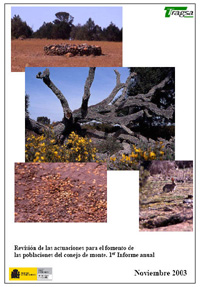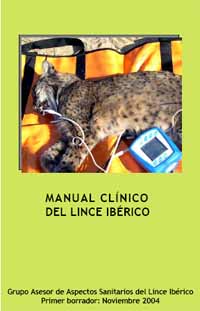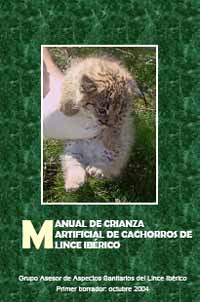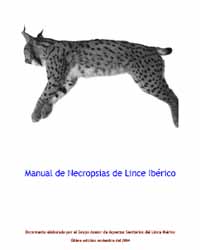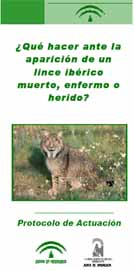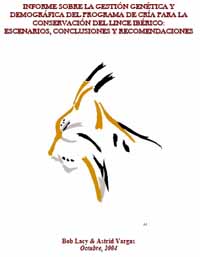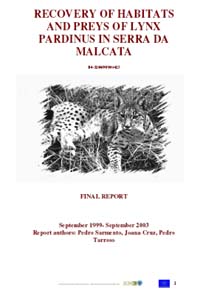|
Célio Alves, P. and Ferreira, C. 2004. |
|
Determination of the relative abundance of rabbit populations in
continental Portugal. Methodology (pp. 4-7): field work, inquiries, hunting bag statistics; data analysis: relative rabbit abundance, population tendency. Field protocols (Annex pp. 22-32): determination of the relative abundance of rabbit populations, information paper on the methodology to use, questionnaire. |
|
|
||
|
Conservacion Ex-situ Lince Iberico. 2004. Programa de Funcionamiento. Centro de Cría del Lince Ibérico El Acebuche, Parque Nacional de Doñana: 1-50. Content: Conservation Breeding Centre El Acebuche: Information on Infrastructure, Working routine, Quarantine, Environmental Enrichment, Emergency plan, Manual on the artificial rearing of lynx kittens. Centro_de_Cria_El_Acebuche_2004_Programa_de_Funcionamiento.pdf |
|
| © Centro de Cría del Lince Ibérico El Acebuche |
|
Ministerio de Medio Ambiente. 2004 |
|
Guide for handling Iberian lynx in captivity: Installations (design, dimensions, furnishing, handling, environmental enrichment), Nutrition (requirements, diet), Reproduction (description of the cycle, handling of the reproducing animals), Breeding (handling of the cubs, hand rearing), Technics of assisted reproduction. |
|
Comite_de_Cria_2004_Borrador_guia_de_manejo_en_cautividad.pdf |
|
Ex-situ Conservation Team. |
|
Ex_situ_Conservation_Team_Iberian_lynx_fecal_collection_protocol.pdf |
|
Fernández, N. Protocolo utilizado para el muestreo anual de abundancias relativas de conejos en Doñana, 2pp. Grupo de Carnívoros - Estación Biológica de Doñana, C.S.I.C. |
| Protocol used for the yearly surveillance of relative rabbit abundance in Doñana (design, period, protocol). |
|
Fernandez_Protocolo_de_muestreo_anual_de_conejos_en_Donana.pdf |
|
|
||
|
García, F. J. 2003. |
|
|
|
The report compiles the work
realized during the first years of work on the rabbit Oryctolagus cuniculus and
the revision of the realized actions for the support of its populations and the
restoration of its habitats, with special interest in the efforts made in the
Spanish lynx areas. | ||
| © F.J. García |
|
|
||
|
Grupo Asesor de Aspectos Sanitarios del
Lince Ibérico. 2004. |
|
|
| © Grupo Asesor de Aspectos Sanitarios |
|
|
||
|
Grupo Asesor de Aspectos Sanitarios del Lince Ibérico. 2004. |
|
|
|
||
| © Grupo Asesor de Aspectos Sanitarios |
|
|
||
|
Grupo Asesor de Aspectos Sanitarios del Lince Ibérico. 2004. |
|
|
|
| ||
| © Grupo Asesor de Aspectos Sanitarios |
|
Grupo Asesor de Aspectos Sanitarios del Lince Ibérico. 2004. |
|
Table with the dates of 89 dead lynx registered in the Doñana area from 1982-2004 (name, sex, age, radio-equipped, date of death, cause of death, location, observations). |
|
Grupo_Asesor_de_Aspectos_Sanitarios_2004_Tabla_Mortalidad_Linces_1982-2004.pdf |
|
|
||
|
Grupo Asesor de Aspectos Sanitarios del Lince Ibérico. 2004. |
|
|
|
| ||
| © Grupo Asesor de Aspectos Sanitarios |
|
Guzman, J. N., García, F. J., Garrote Alonso, G., Pérez de Ayala Balzola, R., Iglesias Llamas, C., and Heredia Armada, B. 2002. Censo-diagnóstico de las poblaciones de lince ibérico Lynx pardinus en España (2000-2002). Extract of pages 15-33 on the survey methods used. |
|
Lynx sightings; indirect indications (sign surveys): sampling design, scat identification, track identification, validation of the method (high density vs. medium-low density areas); unsystematic sampling; camera-trapping: description of the technic, sampling design, validation of the method (different density areas); general output of the methods available. |
|
Guzman_et_al_2002_Censo_diagnostico_del_lince_iberico_en_Espana_-_metodologia |
|
|
||
|
Junta de Andalucía. 2003. Dossier de Protocolos de Actuacion y Seguimiento del proyecto (LIFE02NAT/E/8609): 1-48. |
|
|
|
Protocols for actions in regard to habitat
improvement: shrub management; seeding of pastures; method to capture rabbits; management of the intensive rabbit breeding enclosures, the in-situ rabbit breeding enclosures and the rabbit acclimatization enclosures; rabbit repopulation. Protocols for the surveillance of the rabbit and lynx populations: monitoring of the rabbit populations by means of indirect census of scat countings and direct countings of rabbits, intensive monitoring of rabbits in lynx areas in a 2,5 km raster, systematic monitoring of the Iberian lynx, camera-trapping, sampling of stuffed specimens, coordination of the sanitary surveillance of the wild lynx populations. Junta_de_Andalucia_LIFE_2003_Dosier_de_protocolos_de_actuacion_y_seguimiento.pdf |
||
| © Junta de Andalucía |
|
Junta de Andalucía. 2004. |
|
Design of the trestle of the
artificial trunk (for lynx breeding) and prototyp constructed. |
|
Junta_de_Andalucia_LIFE_2004_Diseno_del_armazon_de_la_trueca_artificial.pdf |
|
Junta de Andalucía. |
| Protocol for the monitoring of the breeding enclosures for rabbit (Methodology for the survey, data collection, counting of scats and latrines). |
|
Junta_de_Andalucia_LIFE_Protocolo_seguimiento_de_cercados_de_cria_de_conejo.pdf |
|
Junta de Andalucía. |
|
Protocol for picking up dead/sick animals. |
|
Junta_de_Andalucia_Protocolo_recogida_de_animales_muertos.pdf |
|
Blanco, J. C., Barrios, L.,
González Oreja, J. A., González Vásquez, J. G., Garza, V., Crema, G.,
Rodriguez, A., Gragera, F., Jordán, G., and Villafuerte, R. 1997. |
|
Chapter 4: Methods for lynx census; methods used in the present study: field work (sightings of lynx presence with the help of interviews and search for signs, situation of the habitat and rabbit populations, lynx problematic), data analysis (criteria for the delimitation of the distribution areas of the lynx, criteria to estimate the lynx abundance and the evolution of the lynx populations), criteria for the zonation of the lynx in Extremadura. |
|
Junta_de_Extremadura_1997_Inventario_Lince_-_Cap4_metodos_lince.pdf |
|
|
||
|
Lacy, B. and Vargas, A. 2004. |
|
|
|
| ||
| © B. Lacy & A. Vargas |
|
Sarmento, P., Cruz, J., Monterroso, P., Tarroso, P., Negrões, N., and Ferreira ,C. 2004. The Iberian Lynx in Portugal. Status survey and conservation action plan. Instituto da Conservacao da Natureza ICN. Internal report. Extract of the pages 11-19 on the field survey methods. |
| Information on: Creating the system, sign searching techniques (focus zones, collected data, sampling effort), camera trapping (photographic devices, attractants, target areas, camera placement, relative abundance of non-target species), box-trapping, lynx detection probability. |
|
Sarmento_et_al_2004_Iberian_lynx_in_Portugal_-_pp11-19_methods.pdf |
|
|
||
|
Sarmento, P., Cruz, J., and
Tarroso, P. 2003. |
|
|
|
Description of the actions carried out: increasing the natural regeneration and density of native tree species, substitution of old trees by new ones in previous plantations, plantation of fruit trees, artificial rabbit warrens, construction of a captive breeding centre for rabbits, recovery of olive groves and chestnut tree plantations, prescription burning in pastures, creation of pastures, management of shrubs through prescribed fire, poaching and forest fires patrolling, rabbita vaccination campaigns, rabbit restocking operations, analysis of the incidence of rabbit epizootic diseases, educational actions, and others. | ||
| © C. Carrapato / P.Sarmento et al. |

